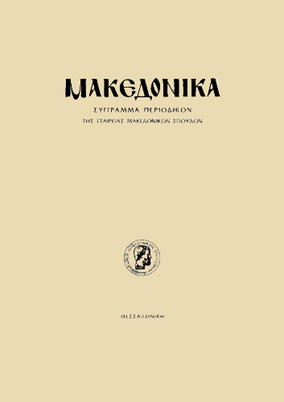Διάγραμμα των χρονικών της Νεολιθικής έρευνας στην Νότια Βαλκανική από το 1984 κ.έξ.
Part of : Μακεδονικά ; Vol.28, 1992, pages 228-267
Issue:
Pages:
228-267
Parallel Title:
Diagram of the chroniche of the Neolithic research in Southern Balkan since 1984.
Section Title:
Articles
Abstract:
The increase, during the last years, of the Neolithic researches made obvious the necessity to collect the new data and to pose again the relevant problems. The new data are collected from East Macedonia, Thrace, Central Macedonia, West Macedonia, Thessaly, South Jugoslavia, Albania, South Bulgaria, European Turkey. Taking into consideration tne new data the following conclusions were drawn:1. Despite the various cultural traditions, the following axis present a homogeneity concerning the architectural, ceramical and other findings: Thessaly —West Macedonia— South Albania. Central Macedonia —South Jugoslavia. East Macedonia— South Bulgaria. Thrace—European Turkey- East Bulgaria. Those axis definitely constitute cultural cycles, with whatever interpretative importance could one attach to this definition, surely not ethno- genetic, since the old interpretative position has been conveyed to other inter pretative forms with a choise of theoretical position-positivist, structural etc,2. The chronological equation of the beginning of the NN with the phase Vinca A is now consolidated.3. The term chalkolithic could be established, but not later than the beginning of the NN and surely only because of the significance attached to it, after the gradual acceptance of the recent correlations that ensue between Anatolia and the Balkans, and knowing its onesidedness as it is only referiing to copper and not to the other autonomies between Anatolia and the Balkans.4. There aren’t any facts to lead us to the acceptance of the existence of fortifications during the NN, moreover to their correlation with the notion of chalkolithic and even a chalkolithic in the late NN (but see Aslanis 1989, 1990, 1991). What is, in my opinion, considered as fortification, at least in the area in whicn we are concerned, must probably be considered as communal work related to formation and especially to levelling for the creation of vital space, while the pile driving, at the boundaries of the settlements, if it is ever proved by excavating, must be considered as bordering or as a fence for the animals or as an action with symbolic character.5. There îemains still the problem of the gap for the phases before the MN III, with the exception of course of Giannitsa. The lack of EN in central- East Macedonia-Thrace must not be considered anymore, I believe, an acci dental fact and a convincing explanation should be searched for.6. The settlements are formed into groups with the most typical example this of the Kitrini Limni (Promelais, Photiades 1987-88). Those groups must have surely have had a political organization in the political sense of the word, they retained however mutuality relations.7. A fact which is certain and accepted by all is the increase of the population during the NN and especially during its advanced phases and the population concentrations in larger in size settlements. If especially this fact is combined with the simultaneous, as I believe, inhabiting — in all their range — settlements of 10 hectares and more, or large «insulae» like those in Selevac, we then perceive that we are dealing with population concentrations of protourbanistic character without however the formation of an hierarchic arrangement in the groups of the settlements. The Neolithic settlements with very high tells comparing to the flat ones do not seem to show a different intercommunal organization from the flat large ones. The difference lies simply to choises related to the characteristics of the ground, that is its formation and its various possibilities. Apart from the views expressed, concerning the gradual changes and the duration of the NN, for the developing of the cultural change one should study also the subject of the internal transformations in the groups of Neolithic settlements in relation to whatever information could be collected concerning the intercommunal transformations.8. There is nothing recent to add on writing and metallurgy. Very likely the use of the metal was analogous with the use of raw materials, such as e.g. this of the flint. That is, copper and gold is used in Dimitra and Sitagrous because there is a nearby source, let us say the one in Pangaion, or others like the settlements of Vasilika and Thermi use the nearby source of flint coming from the quarry of Vasilika. This view seems right (see also Me Green Liritzis 1983, 1988).9. The exchanges were those of surplus. The subject of exchanges should be examined in the frame of the micro-scale of the groups of the settlements, even of those materials that show a mobility of great dinstances, such as the one of sponlylus and flint.
Subject:
Subject (LC):
Notes:
856:https://ejournals.epublishing.ekt.gr/index.php/makedonika/article/view/5714, DOI: https://doi.org/10.12681/makedonika.153
Electronic Resources:




